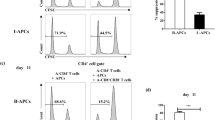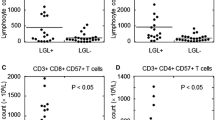Abstract
Functional modulation of regulatory T cells (T-regs) is one possible approach to cancer immunotherapy. In this study, we investigated whether low-dose basiliximab, a chimeric anti-CD25 monoclonal antibody, could suppress the T-regs function not by depletion but by inactivation, and increase immune responses. Peripheral blood mononuclear cells from healthy donors and patients with malignancy were collected. We tried T-regs inactivation using various concentrations of basiliximab before induction of lymphokine-activated killer (LAK) cells. We measured cell proliferation, lymphocyte phenotype, intracellular T-regs maker, and Th1/2 cytokines production. Our results showed that the optimal concentration of basiliximab for specifically down-modulating only T-regs was 0.001 μg/ ml. The reduction of Th-2 cytokine secretion with concomitant APC induction without suppressing cell proliferation offers the promise of a novel adoptive immunotherapy to cancer patients.





Similar content being viewed by others
References
Rosenberg SA, Lotze MT, Muul LM et al (1985) Observation on the systemic administration of autologous lymphokine-activated killer cells and recombinant interleukin-2 to patients with metastatic cancer. N Engl J Med 313:1485–1492
Rosenberg SA, Packard BS, Aebersold PM et al (1988) Use of tumor infiltrating lymphocytes and interleukin-2 in the immunotherapy of patients with metastatic melanoma. A preliminary report. N Engl J Med 319:1676–1680
Aruga A, Yamauchi K, Takasaki K et al (1991) Induction of autologous tumor-specific cytotoxic T cells in patients with liver cancer. Int J Cancer 49:19–24
Kono K, Takahashi A, Sugai H et al (2002) Dendritic cells pulsed with HER-2/neu-derived peptides can induce specific T-cell responses in patients with gastric cancer. Clin Cancer Res. 8:3394–3400
Boczkowski D, Nair SK, Synder D et al (1996) Dendritic cells pulsed with RNA are potent antigen-presenting cells in vitro and in vivo. J Exp Med 184:465–472
Yamaguchi Y, Ohshita A, Kawabuchi Y et al (2003) Adoptive immunotherapy of cancer using activated autologous lymphocytes—current status and new strategies. Hum Cell 16:183–189
Dudley ME, Wunderlich JR, Yang JC et al (2002) A phase I study of nonmyeloablative chemotherapy and adoptive transfer of autologous tumor antigen-specific T lymphocytes in patients with metastatic melanoma. J Immunother 25:243–251
Dudley ME, Wunderlich JR, Yang JC et al (2005) Adoptive cell transfer therapy following non-myeloablative but lymphodepleting chemotherapy for the treatment of patients with refractory metastatic melanoma. J Clin Oncol 23:2346–2357
Phan GQ, Yang JC, Sherry RM et al (2003) Cancer regression and autoimmunity induced by cytotoxic T lymphocyte-associated antigen 4 blockade in patients with metastatic melanoma. Proc Natl Acad Sci USA. 100:8372–8377
Dannull J, Su Z, Rizzieri D et al (2005) Enhancement of vaccine-mediated antitumor immunity in cancer patients after depletion of regulatory T cells. J Clin Invest 115:3623–3633
Augulo R, Fulcher DA (1998) Measurement of Candida-specific blastogenesis: comparison of carboxyfluorescein succinimidyi ester labeling of T cell, Thymidine incorporation and CD69 expression. Cytometry 34:143–151
Katoh M (2002) Expression of human SOX7 in normal tissues and tumors. Int J Mol Med 9:363–368
Sakaguchi S, Sakaguchi N, Asano M et al (1995) Immunologic self-tolerance maintained activated T cells expressing IL-2 receptor α-chains (CD25): breakdown of a single mechanism of self-tolerance caused various autoimmune diseases. J Immunol 155:1151–1164
Shimizu J, Yamasaki S, Sakaguchi S (1999) Induction of tumor immunity by removing CD25+CD4+ T cells: a common basis between tumor immunity and autoimmunity. J Immunol 163:5211–5218
Read S, Malmstrom V, Powrie F (2000) Cytotoxic T lymphocyte-associated antigen 4 plays an essential role in the function of CD25(+)CD4 (+) regulatory cells that control intestinal inflammation. J Exp Med 192:295–302
Takahashi T, Tagami T, Yamazaki S et al (2000) Immunologic self-tolerance maintained by CD25(+)CD4(+) regulatory T cells constitutively expressing cytotoxic T lymphocyte-associated antigen 4. J Exp Med 192:303–310
Hori S, Nomura T, Sakaguchi S (2003) Control of regulatory T cell development by the transcription factor FOXP3. Science 299:1057–1061
Okawaki M, Yamaguchi Y, Okita R et al (2008) Dose-finding study of anti-CD25 antibody for targeting regulatory T cells in locoregional immunotherapy of malignant effusion. Hiroshima J Med Sci 57:37–46
Rowshani AT, Uss A, Yong SL, Lier RAW, Berge IJM (2004) Effect of CD25 monoclonal antibody on proliferative and effector functions of alloactivated human T cells in vitro. Eur J Immunol 34:882–889
Lenschow DJ, Walunas TL, Bluestone AJ (1996) CD28/B7 system of cell costimulation. Annu. Rev Immunol 14:233–258
Caras I, Grigorescu A, Stavaru C et al (2004) Evidence for immune defects in breast and lung cancer patients. Cancer Immunol Immunother 53:1146–1152
Tabata T, Hazama S, Yoshino S, Oka M (1999) Th2 subset dominance among peripheral blood T lymphocytes in patients with digestive cancers. Am J Surg 177:203–208
Kudo-Saito C, Schlom J, Camphausen K et al (2005) The requirement of multimodal therapy (vaccine, local tumor radiation, and reduction of suppressor cells) to eliminate established tumors. Clin Cancer Res 11:4533–4544
Waterhouse P, Penninger JM, Timms E (1995) Lymphoproliferative disorders with early lethality in mice deficient in Ctla-4. Science 270:985–988
Acknowledgements
We thank Ms. Y. Nakatani, M. Funada, and M. Okamura for excellent technical assistance. This study proceeded at the Analysis Center for Life Science, Hiroshima University.
Conflict of interest statement
No funds were received in support of this study.
Author information
Authors and Affiliations
Corresponding author
Rights and permissions
About this article
Cite this article
Okita, R., Yamaguchi, Y., Ohara, M. et al. Functional inactivation of CD4+CD25high regulatory T cells using low dose human/mouse chimeric anti-CD25 monoclonal antibody enhanced lymphokine-activated killer cells activity. Targ Oncol 3, 227–234 (2008). https://doi.org/10.1007/s11523-008-0095-4
Received:
Accepted:
Published:
Issue Date:
DOI: https://doi.org/10.1007/s11523-008-0095-4




